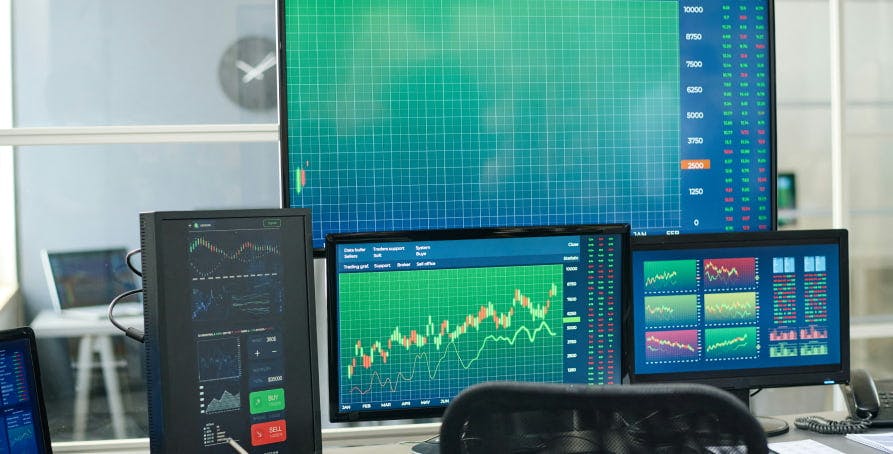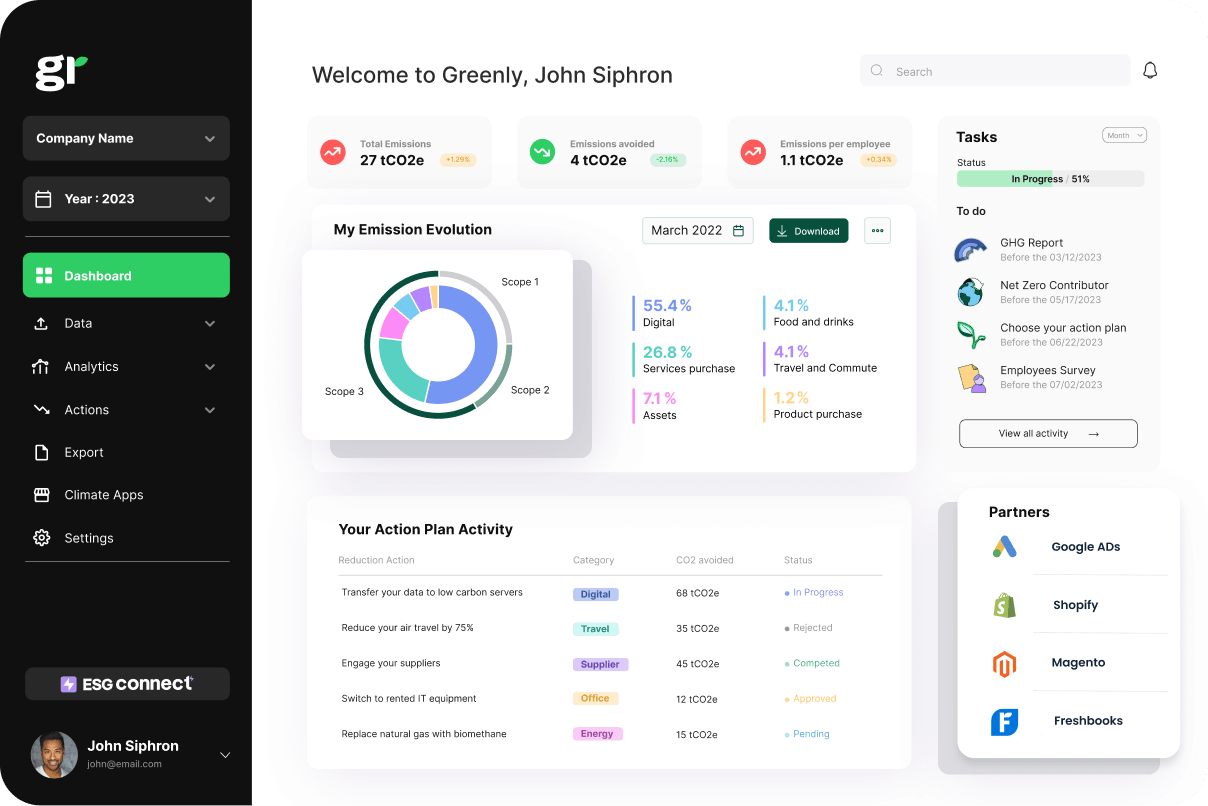
What are the 3 Pillars of Corporate Sustainability?
In this article, we'll explore what the 3 pillars of corporate responsibility are, why they're important, and how businesses can turn them into practical action.
ESG / CSR
Industries



As companies face growing pressure to operate sustainably, many are turning to digital solutions to help navigate the complexities of sustainability management. Sustainability reporting software offers a way for businesses to track their environmental impact, streamline resource use, and stay compliant with ever-evolving regulations. Beyond just crunching numbers, it enables a deeper understanding of a company’s footprint, helping turn environmental goals into actionable strategies.
In this article, we’ll explore five transformative things sustainability software allows you to do - insights that can make a significant difference in how your business approaches sustainability.
Sustainability software encompasses a range of digital tools that enable organisations to track, manage, and report their environmental, social, and governance (ESG) performance.
Designed to support businesses on their sustainable transformation journey, sustainability software centralises data collection and analysis related to carbon emissions, resource use, and compliance with environmental standards. By doing so, it empowers companies to make informed, strategic decisions that contribute to their long-term sustainability goals.
Sustainability software typically includes a range of applications aimed at managing various aspects of environmental impact:
With sustainability software, businesses are better equipped to monitor their progress, adjust strategies in real time, and reduce their overall impact on the environment. These tools have become essential for any organisation aiming to meet sustainability commitments in a measurable and actionable way.
Here are the steps how sustainability software works:
It’s important to remember that sustainability software can manifest and be utilized in multiple different forms, such as applications used to track carbon emissions across the value chain, efforts to set reduction targets, and help in developing sustainability reports.

Here is a breakdown of the different types of sustainability software:
Ultimately, sustainability software could prove as an indispensable tool for companies with large business operations looking to reduce their ESG impact
Remember, regardless of the type of sustainability software chosen – numerous industries can benefit from the use of sustainability management software, collecting ESG data, and carbon accounting software, including:
The best sustainability software can help businesses be increasingly aware of their current environmental impact whilst also ensuring compliance – helping to boost the importance of adhering to sustainable initiatives worldwide.
Let’s take a look at the key features and main benefits of sustainability software:
One of the most powerful capabilities of sustainability software is its ability to measure a company's carbon footprint. Carbon footprint measurements cover all emission scopes: Scope 1 (direct emissions from owned or controlled sources), Scope 2 (indirect emissions from the purchase of energy), and Scope 3 (all other indirect emissions in the value chain). With software tools that centralise this data, companies can achieve a clear view of their environmental impact across operations and their supply chain.
Tracking emissions accurately is crucial for companies looking to set measurable reduction goals and align with science-based targets. Without the right software, gathering and analysing emissions data can be time-consuming and often incomplete, leading to gaps in reporting and missed opportunities for improvement. By centralising data collection and calculations, sustainability software can help companies streamline their reporting process, making emissions tracking a less daunting task.
How Greenly can help: Greenly’s carbon management platform offers businesses a user-friendly way to track their emissions across all scopes. By tailoring data collection and analysis to specific industry needs, Greenly’s software enables companies to monitor their emissions in real time and take actionable steps toward achieving their carbon reduction targets.
Beyond tracking emissions, sustainability software empowers businesses to identify inefficiencies in resource use and minimise waste. By analysing data on energy, water, and raw materials, companies can pinpoint areas where resources are overused or wasted, leading to both environmental and cost-saving benefits. For example, the software might highlight areas of high energy consumption or show patterns of excess material use that could be optimised.
This capability aligns with goals for operational efficiency and initiatives such as the circular economy. Companies committed to reducing their environmental impact can use these insights to support zero-waste targets, promote recycling within the organisation, or explore innovative ways to repurpose resources.
How Greenly can help: Greenly’s platform provides companies with detailed insights into their emissions profile, highlighting areas where emissions are most concentrated. With this data, businesses can make informed decisions to reduce high-emission sources, ultimately supporting cost-saving and emissions-reduction efforts that align with their sustainability goals.
Keeping up with environmental regulations is a critical challenge for businesses today, especially as sustainability standards evolve and expand. Sustainability software simplifies this process by tracking regulatory requirements and providing clear guidelines for compliance. Whether it’s the EU’s Corporate Sustainability Reporting Directive (CSRD) or the UK’s Ecodesign for Sustainable Products Regulation (ESPR), companies can use software to automate compliance tracking, reduce the risk of penalties, and stay aligned with evolving global standards.
The automation of regulatory updates and reporting requirements saves time and ensures that data remains accurate and up-to-date. This capability is essential for businesses looking to stay ahead of regulations, avoid reputational risks, and demonstrate accountability to stakeholders.
How Greenly can help: Greenly’s platform supports companies in aligning with complex sustainability standards, helping them track emissions and ensure transparent reporting that meets regulatory demands.

Transparency has become a cornerstone of modern sustainability practices. As consumers, investors, and employees increasingly prioritise sustainable business practices, companies are under pressure to openly share their environmental impact and progress. Sustainability software facilitates this transparency by generating clear, accessible reports that communicate sustainability goals, achievements, and ongoing challenges.
By making this data available to stakeholders, businesses can build trust, strengthen brand loyalty, and enhance investor confidence. Sustainability software often includes tools that align reporting with frameworks like the Global Reporting Initiative (GRI) or the Carbon Disclosure Project (CDP), simplifying the process of integrating sustainability metrics into annual reports or public disclosures.
How Greenly can help: Greenly’s platform empowers businesses to engage stakeholders effectively by providing transparent, easy-to-understand insights into their emissions data. With Greenly, companies can demonstrate their commitment to sustainability through reliable reporting, fostering trust and accountability with stakeholders.
A company’s supply chain often accounts for a significant portion of its total emissions, but it can be challenging to assess and control these indirect impacts. Sustainability software helps bridge this gap by tracking emissions across the supply chain, from raw material sourcing to product delivery. This insight is critical for companies aiming to reduce their overall environmental footprint, as it allows them to identify high-impact suppliers and areas where improvements can be made.
Understanding and managing supply chain emissions supports a more sustainable approach to business and encourages collaboration with suppliers to adopt greener practices. By gaining visibility into these often-hidden emissions, companies can take actionable steps to improve their environmental performance and strengthen their sustainability credentials.
How Greenly can help: Greenly’s platform offers detailed insights into supply chain emissions, helping companies assess and manage emissions across their entire value chain. In addition to customised action plans, Greenly provides clients with access to a list of sustainable suppliers, allowing businesses to make informed choices that reduce emissions and support a more responsible supply chain.
ESG software, ESG reporting solutions, sustainability data, and sustainability performance can all help your company to not only improve its ESG data collection or to better manage all your ESG data, but it can help to improve your business and employee satisfaction long-term.
Here are some of the additional benefits of greater emissions management and using carbon accounting platforms:
Once companies make use of sustainability software, they can allow for cost deductions and automated data collection can help save time as manual spreadsheets won’t need to be used anymore.
In addition to this, McKinsey, a global consulting firm, estimates that companies may benefit from a 60% increase in operating profits as a result of using various sustainability software.
The use of sustainability software can allow businesses to develop a more robust sustainability strategy as a result of newfound data analysis to help them create more ambitious, complex environmental goals.
In fact, sustainability software can help employees within the business to be more productive as well – as less time and effort is required on their behalf to track and manage carbon emissions within the company.
Lastly, sustainability software can help to draft environmental reports – which will then be shared publicly to boost transparency and accountability. This could help to attract new customers to your business, which is increasingly important considering 80% of people are willing to pay more for a product from a sustainable company.
Companies that use the best sustainability software and eco-friendly practices will inherent greater stakeholder trust and the ability to attract new investors – which can ultimately help to expand the business long-term.
This is also because using sustainability software can encourage new innovative designs to reduce a company’s environmental impact in accordance with the results from the sustainability software’s data analysis.
Therefore, the best sustainability software can also allow businesses to expand their operations and be more successful worldwide.

Choosing the right sustainability software is crucial to reaching your company’s environmental goals. With plenty of options available, understanding the essential features and how they align with your business needs is key to making an informed decision. Here are some important factors to consider:
| Factor | Description |
|---|---|
| Identify Your Key Objectives | Start by clarifying your sustainability goals: Are you focused on carbon emissions reduction, regulatory compliance, or comprehensive ESG reporting? Different software options specialize in areas like emissions tracking and life cycle analysis, helping you focus on your priorities. |
| Evaluate Scope and Features | Ensure the software can manage your specific data needs. If measuring Scope 1, 2, and 3 emissions is essential, seek platforms like Greenly with advanced carbon accounting capabilities. Look for compatibility with frameworks like GRI and CDP for streamlined ESG reporting. |
| Assess User-Friendliness and Integrations | Look for user-friendly software with intuitive dashboards accessible to various departments. Ensure the software integrates with existing systems, such as ERP or CRM platforms, for smooth data collection and analysis. |
| Check for Scalability and Flexibility | Choose software that scales with your company’s growth, adapting to expanded data needs, evolving regulations, and changes in operations. Scalable solutions support long-term growth without needing major modifications. |
| Consider Expertise and Support | A reliable provider with sustainability expertise can offer valuable guidance. Check for strong industry experience, responsive customer support, and regular updates to keep pace with regulatory changes and best practices. |

Selecting the right sustainability software can be transformative, and Greenly’s platform is built to support businesses at every stage of their sustainability journey.
In a world where sustainability is increasingly becoming a business necessity, Greenly is the trusted partner to help you drive impactful change, optimise costs, and enhance your brand’s reputation as a leader in sustainability. Get in touch with us today to find out more.
